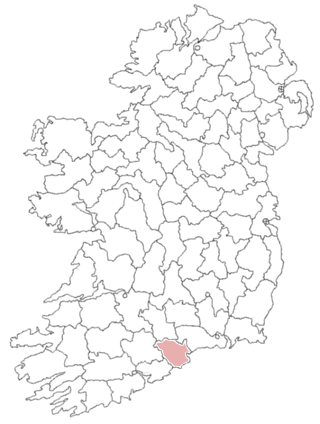Related Research Articles
West Wicklow, a division of County Wicklow, was a parliamentary constituency in Ireland, represented in the Parliament of the United Kingdom. From 1885 to 1922 it returned one Member of Parliament (MP) to the House of Commons of the United Kingdom of Great Britain and Ireland.
East Wicklow, a division of County Wicklow, was a parliamentary constituency in Ireland, represented in the Parliament of the United Kingdom. From 1885 to 1922 it returned one Member of Parliament (MP) to the House of Commons of the United Kingdom of Great Britain and Ireland.
North Monaghan was a parliamentary constituency in Ireland, returning one Member of Parliament (MP) to the House of Commons of the Parliament of the United Kingdom, from 1885 to 1922.
North Mayo was a parliamentary constituency in Ireland, which returned one Member of Parliament (MP) to the House of Commons of the Parliament of the United Kingdom, elected on a system of first-past-the-post, from 1885 to 1922.
South Mayo was a parliamentary constituency in Ireland, which returned one Member of Parliament (MP) to the House of Commons of the Parliament of the United Kingdom, elected on a system of first-past-the-post, from 1885 to 1922.
North Kildare was a UK Parliament constituency in Ireland, returning one Member of Parliament from 1885 to 1922.
South Kildare was a UK Parliament constituency in Ireland, returning one Member of Parliament from 1885 to 1922.
Connemara, a division of County Galway, was a UK Parliament constituency in Ireland, returning one Member of Parliament (MP) from 1885 to 1922.
North Donegal was a UK Parliament constituency in Ireland, returning one Member of Parliament 1885–1922.
South Donegal was a UK Parliament constituency in Ireland, returning one Member of Parliament 1885–1922.
West Donegal was a UK Parliament constituency in Ireland, returning one Member of Parliament from 1885 to 1922.
North Fermanagh was a UK Parliament constituency in Ireland which returned one Member of Parliament from 1885 to 1922, using the first past the post electoral system.

West Waterford was a UK Parliament constituency in Ireland, returning one Member of Parliament from 1885 to 1918.
North Westmeath was a constituency in Ireland, returning one Member of Parliament to the United Kingdom House of Commons from 1885 to 1918.
Leix, a division of Queen's County, was a constituency in Ireland, returning one Member of Parliament to the United Kingdom House of Commons from 1885 to 1918.
North Louth was a parliamentary constituency in Ireland, which returned one Member of Parliament (MP) to the House of Commons of the Parliament of the United Kingdom, elected on a system of first-past-the-post, from 1885 to 1918. Prior to the 1885 general election and after the dissolution of Parliament in 1918 the area was part of the Louth constituency.
South Leitrim was a parliamentary constituency in Ireland. From 1885 to 1918 it returned one Member of Parliament (MP) to the House of Commons of the United Kingdom of Great Britain and Ireland.
East Tyrone was a UK parliamentary constituency in Ireland. It returned one Member of Parliament (MP) to the British House of Commons from 1885 to 1918.
North Tyrone was a UK parliamentary constituency in Ireland. It returned one Member of Parliament (MP) to the British House of Commons 1885–1918.
Mid Antrim was a UK Parliament constituency in Ireland which returned one Member of Parliament from 1885 to 1922, using the first past the post electoral system.
References
- Walker, Brian M., ed. (1978). Parliamentary Election Results in Ireland, 1801–1922. Dublin: Royal Irish Academy. ISBN 0901714127.
- Leigh Rayment's Historical List of MPs – Constituencies beginning with "M" (part 2)